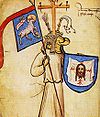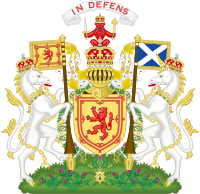Portal:Heraldry
Welcome to the Heraldry and Vexillology Portal!


Heraldry encompasses all of the duties of a herald, including the science and art of designing, displaying, describing and recording coats of arms and badges, as well as the formal ceremonies and laws that regulate the use and inheritance of arms. The origins of heraldry lie in the medieval need to distinguish participants in battles or jousts, whose faces were hidden by steel helmets.
Vexillology (from the Latin vexillum, a flag or banner) is the scholarly study of flags, including the creation and development of a body of knowledge about flags of all types, their forms and functions, and of scientific theories and principles based on that knowledge. Flags were originally used to assist military coordination on the battlefield, and have evolved into a general tool for signalling and identification, particularly identification of countries.
Selected coat of arms
The coat of arms of Singapore is the heraldic symbol representing the Southeast Asian island nation of Singapore. It was adopted in 1959, the year Singapore became self-governing within the British Empire. At the centre of the emblem is a red shield bearing a white crescent (a new moon, representing a rising young nation) and five white stars (representing various national ideals including multiculturalism). While the use of the coat of arms is restricted to the government, the symbol enjoys wide use on the national currency and state decorations, and appears on the cover of the national passport.(more...)
Selected article

Attributed arms are coats of arms given to legendary figures, or to notable persons from times before the rise of heraldry. Beginning in the 12th century, imaginary arms were assigned to the knights of the Round Table, and soon arms were given to biblical figures, to Roman and Greek heroes, and to kings and popes who had not historically borne arms. The specific arms could vary, but the arms for major figures soon became fixed.
Notable arms attributed to biblical figures include the arms of Jesus based on the instruments of the Passion, and the shield of the Trinity. Medieval literature attributed coats of arms to the Nine Worthies, including Alexander the Great, Julius Caesar, and King Arthur. Arms were given to many kings predating heraldry, including Edward the Confessor and William I of England. These attributed arms were sometimes used in practice as quarterings in the arms of their descendants. (more...)
Selected flag

The national flag of the Philippines is a horizontal bicolor with equal bands of blue and red, and with a white equilateral triangle based at the hoist side; in the center of the triangle is a golden yellow sun with eight primary rays, each containing three individual rays; and at each corner of the triangle is a five-pointed golden yellow star. The flag is displayed with the blue field on top in times of peace, and with the red field on top in times of war. The design was conceptualized by Emilio Aguinaldo during his exile in Hong Kong in 1897, and formally adopted in 1898. The flag's colors have varying symbolism, and the shade of blue has changed over time. (more...)
Selected picture

The Royal Coat of Arms of Scotland was the official coat of arms of the monarchs of Scotland and the Kingdom of Scotland until the Union of the Crowns in 1603.
Did you know...
- ...that the Dannebrog (pictured) is the oldest state flag in the world still in use, with the earliest undisputed source dating back to the 14th century?
- ...that Donal McLaughlin, as part of a team led by Oliver Lincoln Lundquist, designed a logo for the 1945 United Nations Conference on International Organization that became the model for the Flag of the United Nations?
- ...that the cross in the coat of arms of Colchester represents the True Cross, as discovered by Saint Helena of Constantinople, the patron saint?
- ...that politicians proposed replacing the red lion on the Flag of Tasmania with a thylacine or Cape Barren Goose?
- ...that a romantic scene in Sir Walter Scott's Ivanhoe refers to an area near Smisby in Derbyshire which was thought to have been used for ancient jousting battles?
Related portals
|
|
|
Heraldry Web resources
Authorities
- Belgium - The Council of Nobility, Flemish Heraldic Council and Council of Heraldry and Vexillology of the French Community
- Canada - Canadian Heraldic Authority and see also Public Register of Arms, Flags and Badges
- England, Wales, and Northern Ireland - The College of Arms
- Ireland - The Office of the Chief Herald of Ireland
- Netherlands - High Council of Nobility
- Portugal - Instituto da Nobreza Portuguesa
- Scotland - The Court of the Lord Lyon
- South Africa - South African Bureau of Heraldry
- Sweden - National Board of Heraldry, The National Archive
- United States Army - The United States Army Institute of Heraldry
Societies
- Greek Heraldry Society
- The Academy of Heraldic Science Czech republic
- The American College of Heraldry
- The American Heraldry Society
- The Augustan Society
- The Australian Heraldry Society Inc.
- Bulgarian Heraldry and Vexillology Society
- The Center for Research of Orthodox Monarchism
- Cambridge University Heraldic and Genealogical Society
- Chiltern Heraldry Group
- The College of Dracology
- Croatian Heraldic and Vexillologic Association
- The Finnish Heraldic Society
- Fryske Rie foar Heraldyk
- Hellenic Armigers Society
- Guild of Heraldic Artists
- Genealogical Society of Ireland
- Heraldry Research Institute (Japan)
- The Heraldry Society
- The Heraldry Society of Africa
- The Heraldry Society of New Zealand Inc.
- The Heraldry Society of Scotland
- The Heraldry Society of Southern Africa
- The Institute of Heraldic and Genealogical Studies
- The International Association of Amateur Heralds
- Italian Center of Vexillological Studies
- Lancashire Heraldry Group
- Macedonian Heraldry Society
- New England Historic Genealogical Society Committee on Heraldry
- Norwegian Heraldry Society
- Oxford University Heraldry Society
- Polish Heraldry Society
- Polish Nobility Confederation
- Real Academia Matritense de Heráldica y Genealogía - Royal Academy of Heraldry and Genealogy of Madrid
- Romanian Institute for Genealogy and Heraldry
- The Royal Heraldry Society of Canada
- The Russian College of HeraldryThe Russian College of Heraldry
- Serbian Heraldic Society
- Societas Heraldica Scandinavica
- Societas Heraldica Slovenica
- Swedish Heraldic Society
- Ukrainian Heraldry Society
- Royal Association Genealogical and Heraldic Office of Belgium
Vexillology
Software
- Coat of Arms Visual Designer web-based program
- Puncher Heraldry Program
- Blazonry Server - pyBlazon
- DrawShield - creates SVG shield or arms image from blazon
- CoaMaker - web-based tool
- Blazon95 and BLAZONS! 2000, older Windows applications
Texts
- Heraldry, historical and popular : with seven hundred illustrations (1863)
- A Complete Guide to Heraldry (1909)
Other
Wikimedia
The following Wikimedia Foundation sister projects provide more on this subject:
-
Commons
Free media repository -
Wikibooks
Free textbooks and manuals -
Wikidata
Free knowledge base -
Wikinews
Free-content news -
Wikiquote
Collection of quotations -
Wikisource
Free-content library -
Wikispecies
Directory of species -
Wikiversity
Free learning tools -
Wikivoyage
Free travel guide -
Wiktionary
Dictionary and thesaurus












